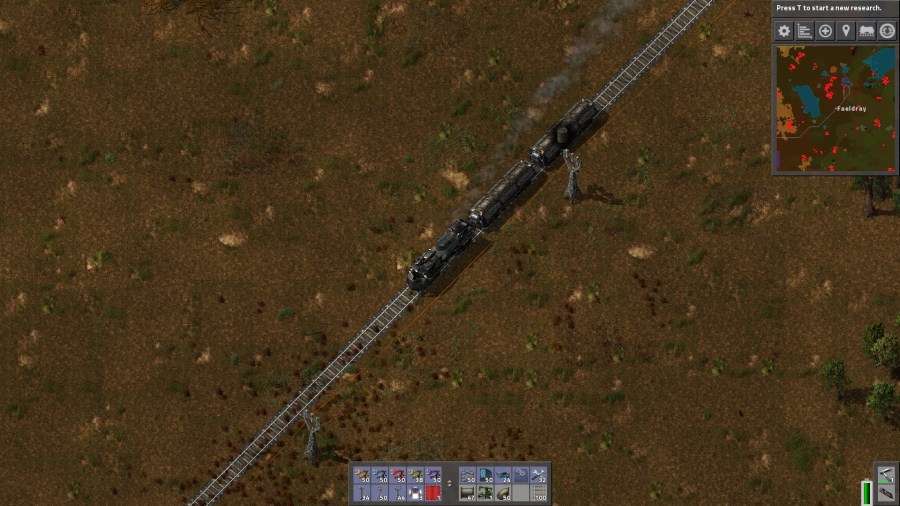Factorio: co-op automation
As far as I know, Factorio is a game that is pretty unique. Sure, it has resource management and base building, but it’s mostly about automation. And not just being a “god” character setting a group of peons to do something. It’s about making machines, to make more machines, which in turn makes even more machines.
I’ve known about the game for a while because Lord Crumb loves it. I had attempted the tutorial long ago and hadn’t gotten any far. But after I had played the Minecraft modpack Agrarian Skies 2, and Lord Crumb and I had duo-ed the similar modpack Project Ozone, I developed a taste for automation. I found that there’s something satisfying about putting together systems of machines, systems that generally get more complicated as you progress. And it also helps to negate the need to grind resources. So one day I bought Factorio and that became our next co-op game.
While Factorio’s multiplayer is apparently still under development, we had no problems playing the game together. There were a few moments of lag or disconnect but they could certainly be attributed to the usual internet problems of trying to play with someone on another continent.
As you can imagine, we began small. Coal-fueled mining drills fed into coal-fueled furnaces and crafting a lot of things by hand. As soon as was possible, steam boilers and engines were put down.
Using conveyor belts, inserters, and assembly machines, we began to automate more and more components.
As we grew, our power needs became greater and coal is inefficient. So we needed to start drilling for oil.
And converting it into solid fuel, a much better fuel source.
Unfortunately, what works at the beginning quickly become unmanageable. If you find that you need to produce more of something, it’s hard to put down new assembly machines when there’s no room. So Lord Crumb, being the veteran player here, told me how dedicated “districts” were the answer. He started with the iron ore processing district when we unlocked electric furnaces, the highest tier of furnace.
This meant that we would need a lot more room. While forests are often nice to have around because they offset pollution which sets off alien attacks, we were playing with the aliens set to passive so that was not a concern. Down came the trees, with the help of robots.
And fire thanks to a flame thrower.
Much fire.
I swear to god, Lord Crumb finds a way to be a pyromaniac in every game we play.
Any materials made were added to a series of belts all going in the same direction, a “trunk” that could be split off of when certain materials were needed to make something else. So after a lot of reworking, our base looked like this:
It was a lot of work to set up (thank goodness you can pick up and move every single piece of machinery) and I’ll admit to not seeing the advantage at first. But once we found out that we needed to produce more of this or that, it was very easy to just extend manufacturing branches southward to accommodate more assembly machines.
As we ran out of materials close to home (first oil and then iron and copper), the train system became extremely important.
And also fun to ride in. I may or may not have said “choo choo!” every time I rode in one.
Soon we were sending trains all over the map to get resources. It’s amazing how fast we went through oil. (The red overlay show pollution.)
That is until we managed to switch almost entirely over to solar power. I don’t know how many solar panels we made but it was definitely in the thousands. Thankfully by that time, we had enough robots and roboports to leave the task to them.
Robots are amazing by the way. They can cut down trees, place machines, or carry items from one place to another (including your inventory) in ways that transport belts just can’t. They’re also kind of mesmerizing to watch work. Like little metal worker bees.

All this time, we were working towards one goal: the rocket which is the game’s win condition. First we needed to build the rocket silo. (Another thing Lord Crumb has to do in every game: make a reference to Britain.)
Then the materials for the actual rocket needed to be made and added to the silo. Once the rocket was complete, it was time for…lift off!
All in all, the time from start to finish took about 40 hours of gameplay. Going by the $1/hour rule, getting 40 hours out of a $25 game is pretty good in my book. And possibly more in the future as the game is in Early Access (but feels pretty complete even now). I enjoyed it almost all the way through; the end was just a little boring because we were just waiting for the rocket to complete. There is the option to continue playing after the rocket launch but for me, that was a good stopping point.
If you’re at all interested in the game, there’s a demo available on Steam that I highly recommend that you play. If you’re especially intrigued by the multiplayer aspect, it’s easy to connect to a game through Steam and you can play with as many friends as you like (unless you have more than 65535 friends).
Bonus Round: Funny Screenshots (because 17 regular screenshots weren’t enough)
Lord Crumb puts me in prison for going AFK for too long.
The resulting materials-vomit when you have a full inventory and cancel the items you had in your crafting queue.
Lord Crumb lighting himself on fire because…reasons? I think it was just for shits and giggles.



















